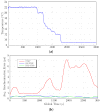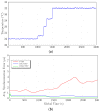Homomorphic Filtering for Improving Time Synchronization in Wireless Networks
- PMID: 28425955
- PMCID: PMC5426833
- DOI: 10.3390/s17040909
Homomorphic Filtering for Improving Time Synchronization in Wireless Networks
Abstract
Wireless sensor networks are used to sample the environment in a distributed way. Therefore, it is mandatory for all of the measurements to be tightly synchronized in order to guarantee that every sensor is sampling the environment at the exact same instant of time. The synchronization drift gets bigger in environments suffering from temperature variations. Thus, this work is focused on improving time synchronization under deployments with temperature variations. The working hypothesis demonstrated in this work is that the clock skew of two nodes (the ratio of the real frequencies of the oscillators) is composed of a multiplicative combination of two main components: the clock skew due to the variations between the cut of the crystal of each oscillator and the clock skew due to the different temperatures affecting the nodes. By applying a nonlinear filtering, the homomorphic filtering, both components are separated in an effective way. A correction factor based on temperature, which can be applied to any synchronization protocol, is proposed. For testing it, an improvement of the FTSP synchronization protocol has been developed and physically tested under temperature variation scenarios using TelosB motes flashed with the IEEE 802.15.4 implementation supplied by TinyOS.
Keywords: 802.15.4; TelosB; TinyOS; WSN; clock skew; homomorphic filtering; oscillators; synchronization; temperature; tuning-fork.
Conflict of interest statement
The authors declare no conflict of interest.
Figures










References
-
- Akyildiz I., Melodia T., Chowdhury K. A survey on Wireless Multimedia Sensor Networks. Comput. Netw. 2007;51:236–255. doi: 10.1016/j.comnet.2006.10.002. - DOI
-
- Soro S., Heinzelmann W. A Survey of Visual Sensor Networks. Adv. Multimed. 2009;2009:1–21. doi: 10.1155/2009/640386. - DOI
-
- Atzoria L., Ierab A., Morabitoc G. The Internet of Things: A survey. Comput. Netw. 2010;54:2787–2805. doi: 10.1016/j.comnet.2010.05.010. - DOI
-
- Deshpande A., Guestrin C., Madden S.R., Hellerstein J.M., Hong W. Model-driven Data Acquisition in Sensor Networks; Proceedings of the Thirtieth International Conference on Very Large Data Bases—Volume 30. VLDB Endowment, (VLDB ’04); Toronto, ON, Canada. 31 August–3 September 2004; pp. 588–599.
LinkOut - more resources
Full Text Sources
Other Literature Sources

